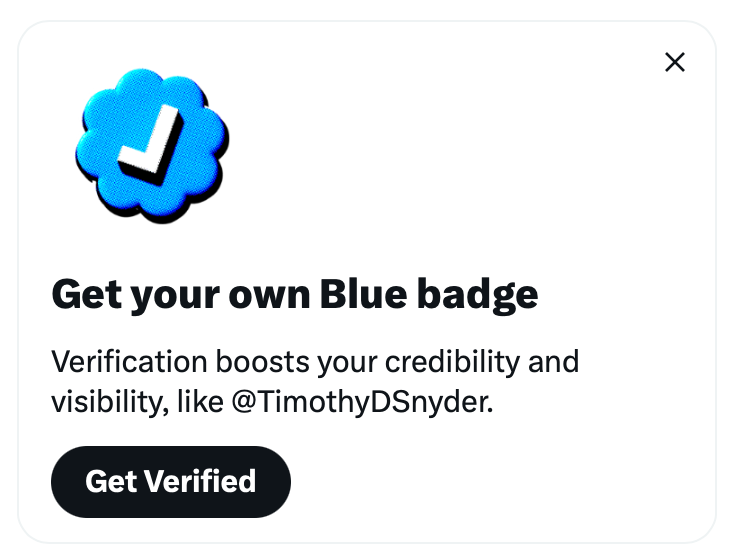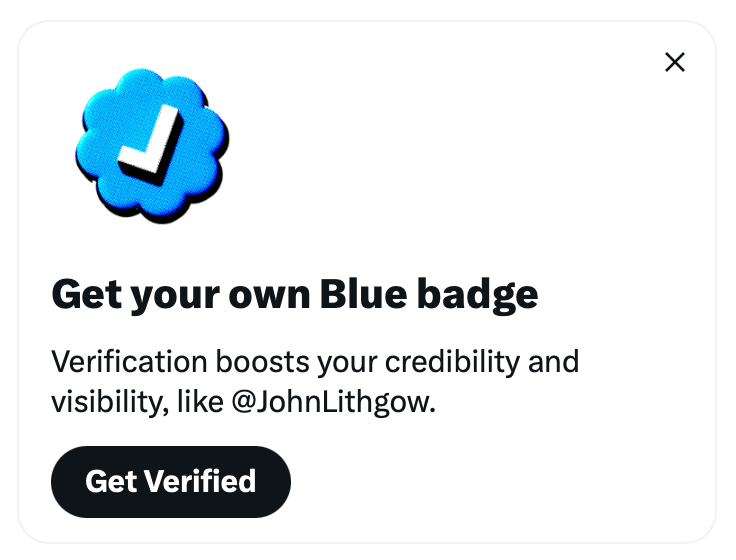Make more online, for less. Buy a domain and everything else you need.
A Slightly Expanded Footnote on Why Timothy Snyder should Leave X/Twitter (and Substack)
I included this footnote in my aforelinked Timothy Snyder/John Lithgow piece:
Linked reluctantly to Snyder’s Substack site. I wish he would leave Substack already. While I’m at it, he should stop posting to X/Twitter, too. He already has a vibrant Bluesky following. His continued presence on those sites drives revenue and attention to them.
It made my point, but I wanted to expand slightly on one aspect of the impact of Snyder’s X/Twitter presence. It became too unwieldy for a footnote, so here we are.
First, regarding Substack: There are plenty of really good, long-standing reasons why Snyder should abandon Substack. I won’t belabor that.
As for X/Twitter, Snyder has a “Verified” account. This means he signed up to pay the execrable Elon Musk at least $7 a month for a blue checkmark next to his name. So did John Lithgow and many businesspeople, brands, authors, influencers, and activists—many of whom, I’d wager, would express personal distaste for the man whose business they willingly support with their money and attention, thus fueling his ability to continue wreaking havoc on our democracy.
Paying for Premium is the only way to get a blue verified checkmark today:
Starting April 1, 2023 we began winding down our legacy Verification program and accounts that were verified under the previous criteria (active, notable, and authentic) will not retain a blue checkmark unless they are subscribed to X Premium.
Let’s put aside the obvious protection racket of having “paid verification systems”—which amount to little more than “it would be a shame if someone impersonated you”—because what’s more irksome is that X/Twitter uses the fact that these well-known, supposedly respectable people have paid for protection—I mean, Premium accounts—as a way to drive more subscribers to Premium by prominently placing ads for the service on the site, with this come-on:
Get your own Blue badge
Verification boosts your credibility and visibility, like @TimothyDSnyder.”


Every verified account you view displays this ad (until you dismiss it)—they’re paying to be exploited.
Gross.
After a Year-Long Pause, Apple Resumes Advertising on the Anti-Democracy, Nazi-Supporting X/Twitter
Apple this month started advertising on X for the first time in more than a year. The company had stopped advertising on the social media platform in November 2023 following controversial remarks made by its owner Elon Musk.
Tim Cook “personally” donated $1,000,000 to, and attended, Donald Trump’s inauguration. Then Apple complied with the Gulf of Mexico name-change nonsense, despite no legal requirement to do so. Now, they’ve restarted advertising on Elon Musk’s toxic social media service, just weeks after Musk gave a Nazi salute.
My only conclusion is that Tim Cook and Apple support this autocratic regime and its brazen, systematic destruction of American democracy.
This latest act of acquiescence is clearly meant to curry favor with Trump and co-President Musk[1] out of fear of retaliation—especially from Musk, who’s actively suing companies who stopped advertising on X/Twitter[2]. No doubt Cook and Co. are hoping to avoid that, making the resumption of ads a bribe to Musk—or, if you’d like to be more generous to Apple, a payoff coerced through blackmail and extortion.
At this point, if Trump demanded that Apple create a backdoor allowing access to every customer’s device, I have very little reason to believe they’ll refuse the request.
I’ve been following Apple for over four decades, first as a customer, then as an employee for twenty-two years. While I won’t claim any unique insight from this tenure, it forged in me a belief that Apple always tries to do the right thing, even when it doesn’t appear that way from the outside. Or, in human terms, their heart was always in the right place.
I can no longer confidently say I believe that.
Leave X/Twitter Today
Nitish Pahwa, in a Slate piece densely packed with receipts:
Now that Trump is headed back to the White House, with X’s Elon Musk in tow, there is not even a pretense of hope on that platform for anyone who voted against Trump. It’s better late than never, but it’s well and truly time to cut X loose.
Maybe it seemed, once, that a spirited internal resistance could effectively limit Musk's damage and preserve some of the prior spirit of the microblogging platform that writers, public agencies, and other creative types had come to depend upon. I honestly cannot tell you what exactly was my justification for maintaining a Twitter/X presence, even as I explored other social media outfits and publicly acknowledged that Musk's regime was repelling masses of tweeters, boosting easily debunkable disinformation, shedding all of X's remaining utility for journalists, bullying transgender users, spreading straight-up white-supremacist rhetoric, and influencing CEOs in every other field to become as domineering and unapologetic as Musk is, whatever the backlash.
I refuse to fuel Musk’s algorithms with my content and attention. I started winding down my participation in October 2022 (after first trying to do so in 2018). I had several “professional obligations” on it at the time that made it impossible for me to fully disengage, but once those obligations no longer existed, I stopped posting on X/Twitter, and only read it when someone links to something over there.
(I then bleach my eyeballs, because yeeech.)
The only people still in the Nazi bar either are Nazis, like Nazis, or enjoy debating Nazis; or who—despite all the Nazi insignia, salutes, and propaganda surrounding them—still don’t believe they’re in a Nazi bar. Perhaps they’re busy nursing their carefully curated follow list in a back corner, and haven’t realized how many of their not-Nazi friends already left or are grabbing their coats. Or their friends are waiting on them to rise and head for the door so they can follow.
Or, perhaps, they don’t know better bars exist.
Today, the three meaningful alternatives to X/Twitter are Bluesky, Threads, and Mastodon. I chose Mastodon, because it’s because it’s not owned by any (billionaire) individual, and it’s where most of my (generally geeky) people are. It’s big advantage is it’s decentralized: there are multiple servers talking to each other rather than one single, central server. A benefit of this is you can join a server based on topic or affinity (e.g. technology, journalism, or activism). The biggest downside? It’s decentralized, which requires you to choose a server (in the way you choose an email provider) with no easy way of comparing them, and the getting started process can be arduous for many non-techie folks.
More and more people are moving from X/Twitter, some 700,000 in a week to Bluesky alone, according to Jay Peters at The Verge:
Bluesky gained more than 700,000 new users in the last week and now has more than 14.5 million users total, Bluesky COO Rose Wang confirmed to The Verge. The “majority” of the new users on the decentralized social network are from the US, Wang says. The app is currently the number two free social networking app in the US App Store, only trailing Meta’s Threads.
That’s the second large influx recently:
The independent platform has seen a lot of growth in recent weeks — on October 24th, Bluesky announced it had 13 million users. After X’s recent announcement that it would let blocked users still see posts from the person that blocked them, for example, Bluesky said it added 500,000 new users in one day.
Many friends are happy on BlueSky. Some prefer Meta/Facebook’s Threads (though I’m not a fan of Mark Zuckerberg any more than I am of Elon Musk). I have accounts on both, mainly as a hedge, in case someone I really care about is active on one of them.
The Verge offers more specific advice on how to leave X/Twitter, including taking your account private, downloading your content, and eventually deactivating your account completely.
Regardless of which new social network you choose, it’s important to start the process now. The best time to leave a Nazi bar is the day it becomes one. The next best time is today.

